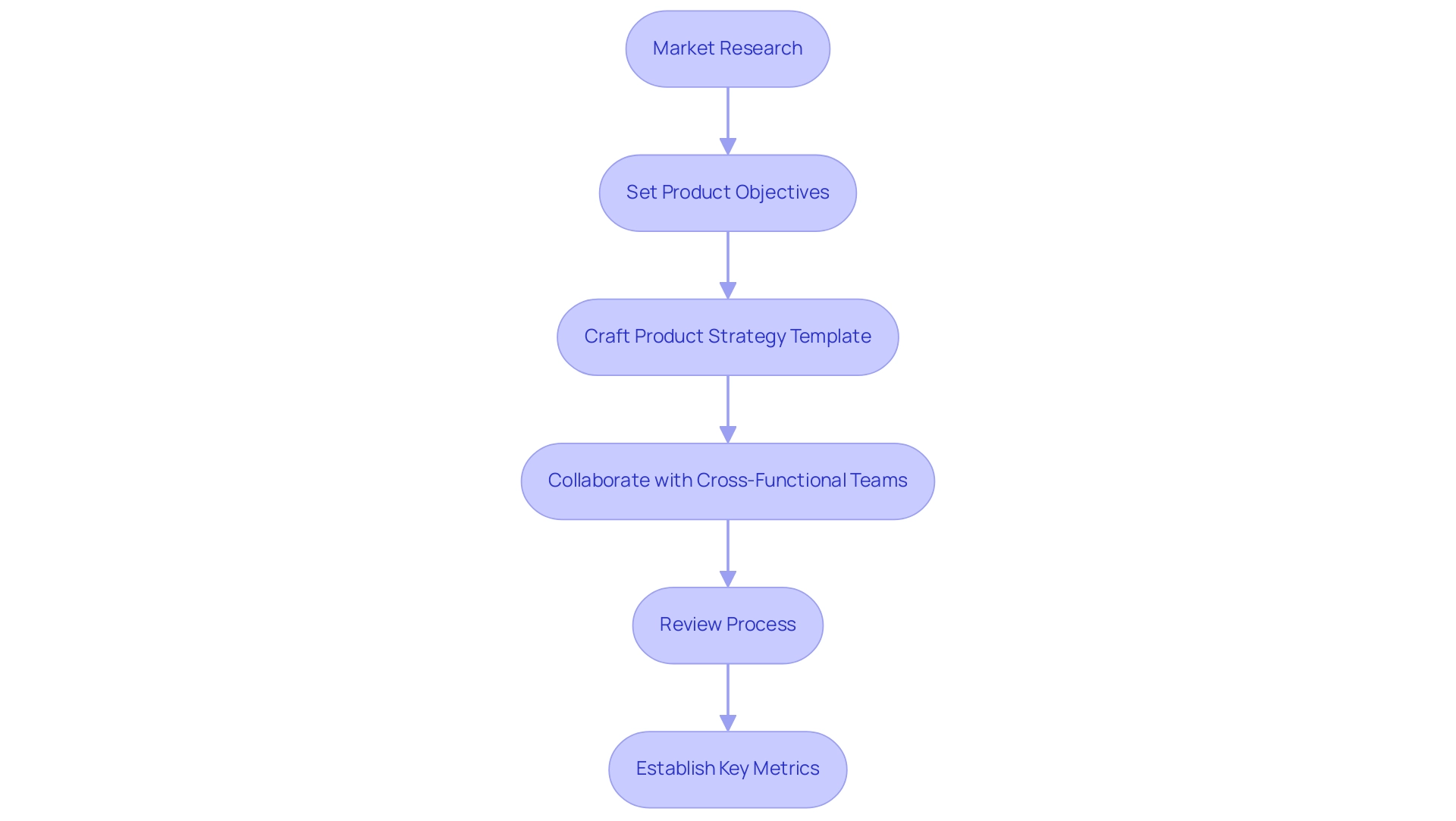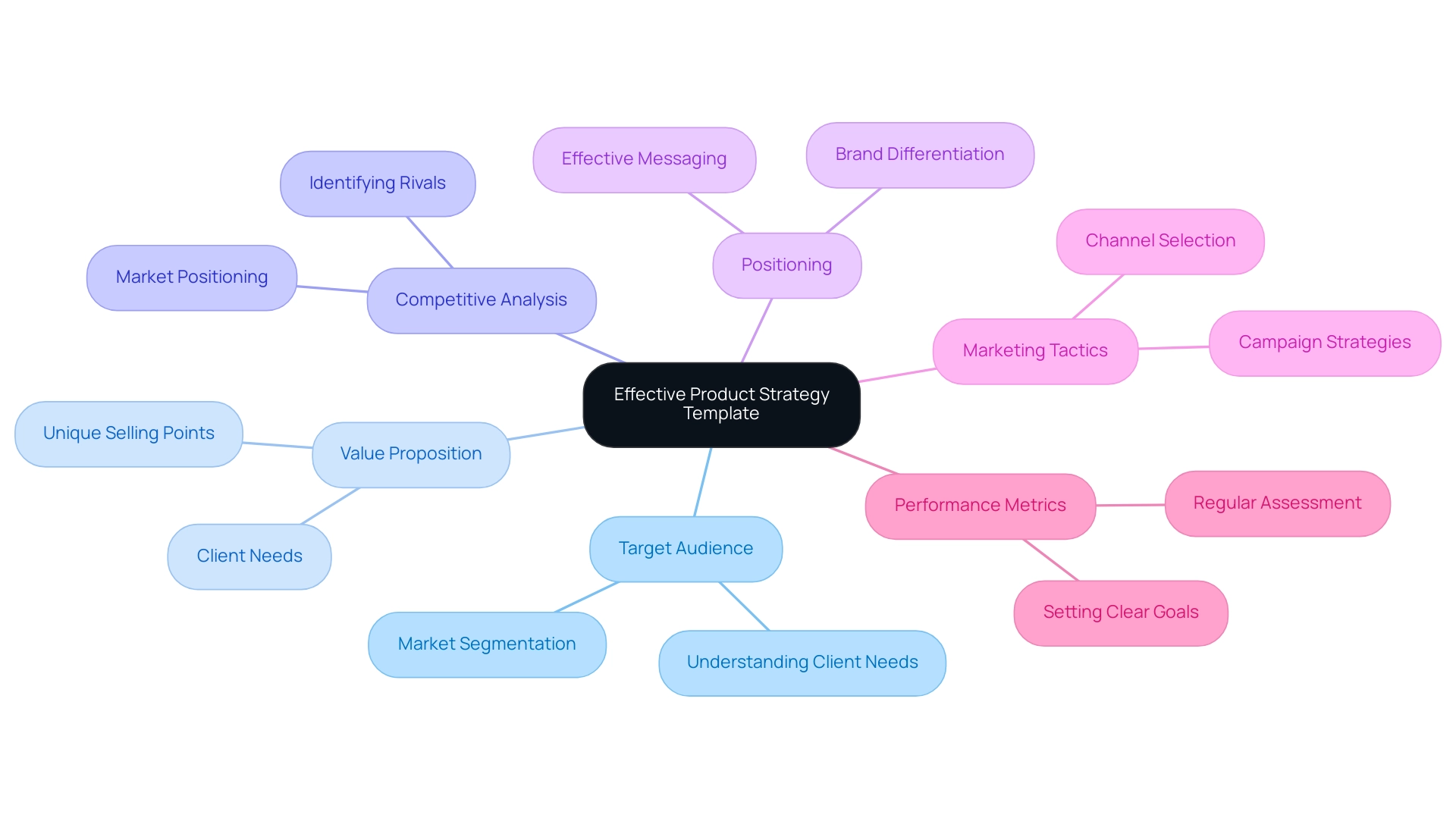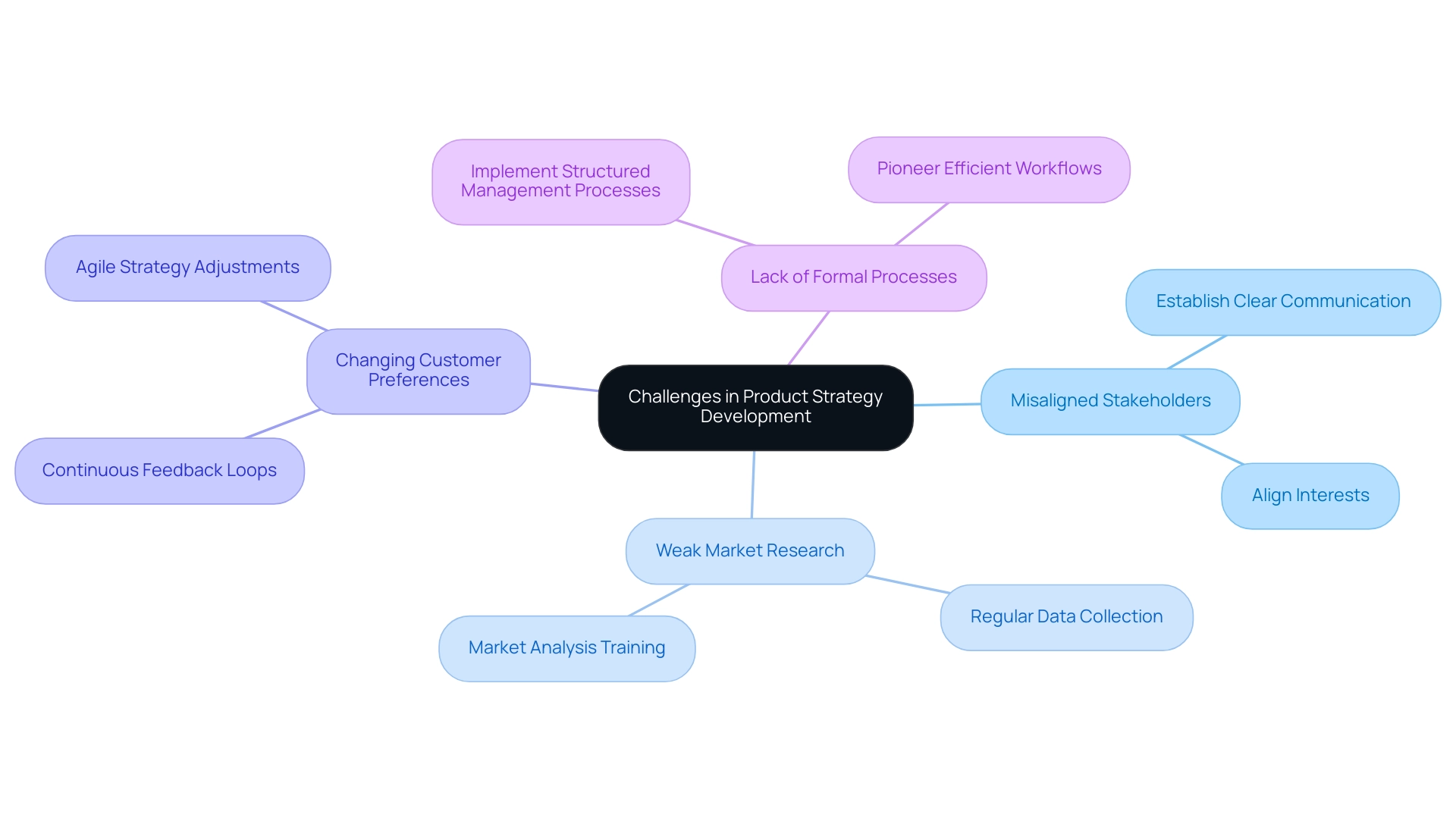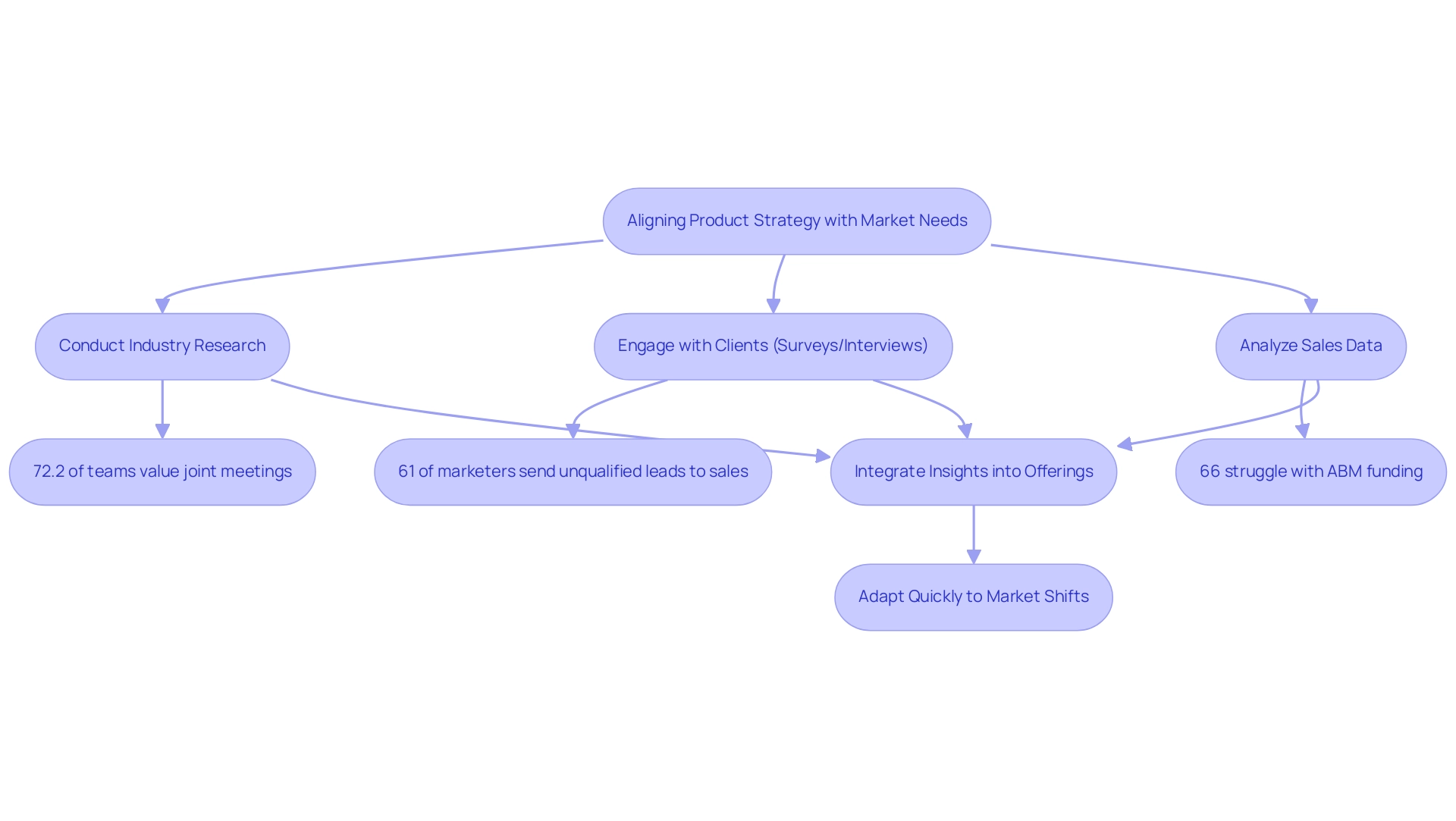What is a product strategy template? Understanding its importance and components

Introduction
In the competitive landscape of product management, a well-defined product strategy template serves as a vital tool for organizations aiming to articulate their vision and navigate the complexities of market demands. This structured framework not only aligns stakeholders around key objectives but also enhances the effectiveness of product development efforts.
With the rapid evolution of trends such as product-led growth and ethical considerations, the necessity for a robust strategy template has never been more pronounced. By understanding its critical components and following a systematic approach to drafting a comprehensive product strategy document, companies can position themselves for success in an ever-changing environment.
This article delves into the essential elements of product strategy, the steps to create an actionable document, and the challenges that product managers face in aligning their strategies with market insights.
Defining a product strategy template: What it is and why it matters
A product strategy template isn’t just a nice-to-have; it’s a necessity. Think of it as the blueprint for your business. It lays out your vision, goals, and tactics in a way that keeps everyone on the same page. When you have a solid plan, you ensure that all stakeholders are aligned on what matters most. Here’s the kicker: about 60% of managers have basic analytics skills. That means they can pull insights on their own, which is crucial when it comes to applying that product strategy template effectively.
Now, let’s talk about the future. The case study “Management in 2024 and Beyond: A Glimpse into the Future” highlights a changing management landscape. We’re seeing trends like growth-driven strategies and ethical management. Companies need to adapt or risk being left behind. A well-defined product strategy template is your lifeline here. It keeps your team focused and coherent throughout the product’s lifecycle, which is essential for better positioning and higher success rates. Plus, continuous delivery methodologies can turbocharge this process, cutting launch times by up to 90%.
And here’s the good news: you don’t have to reinvent the wheel. By using templates for your offerings and tapping into free tools like the battlecard generator and requirements document writer, you can anticipate industry shifts and pivot your strategies for 2024 and beyond. This isn’t just about keeping up; it’s about staying ahead.

Key components of an effective product strategy template
A solid product strategy template isn’t just a checklist; it’s your roadmap for success. It starts with knowing your target audience inside and out. You need a compelling value proposition that speaks to their needs. Don’t forget competitive analysis — understanding your rivals is crucial. Position your offering effectively, choose your marketing tactics wisely, and set clear performance metrics. Each of these components isn’t just nice to have; they’re essential. Focus on the core elements that deliver 80% of your results. That’s where you should put your energy.
The value proposition is your secret weapon. It defines what makes your offering unique and valuable to users. If you can’t articulate that, you’ll struggle to attract and keep clients. As Brian De Haaff, co-founder and CEO of Aha! , puts it, understanding the difference between strategic planning, the approach, and the plan itself is key. This clarity helps you avoid getting stuck in the planning trap and instead focus on creating real solutions for real problems.
You also need to stay agile. Regularly assess your strategy against actual progress. This isn’t just about ticking boxes; it’s about making timely adjustments that align with client needs and market shifts. Take upselling as an example. If you can find ways to solve related problems for your current clients, you’re not just promoting upgrades — you’re driving new revenue and boosting client engagement. It’s all about staying relevant and responsive in a fast-changing landscape.

Steps to drafting a comprehensive product strategy document
Creating a solid product strategy template isn’t just a box-checking exercise. It’s the backbone of your product’s success. Let’s break it down step by step.
First off, market research is non-negotiable. You need to dig deep into customer needs and preferences. Take AmazonBasics Batteries as an example. They didn’t just throw a product out there; they studied the landscape and chose a cost-driven approach. By pricing lower than giants like Duracell or Energizer, they showed how effective pricing strategies can make a difference.
Next, you have to set clear product objectives that align with your business goals. This isn’t just about making a checklist — it’s about ensuring that every move you make contributes to the bigger picture. Once you have those objectives, it’s time to craft your product strategy template. This should include key components like:
- Pricing methods
- Target market segments
- Competitive analysis
A Product Roadmap is your friend here. It lays out specific features, timelines, and milestones, giving you a clear path to follow.
Collaboration is crucial. Working with cross-functional teams can bring in valuable insights. Different departments can shine a light on aspects you might overlook, making your strategy more comprehensive. Take Product Marketing Managers as a case in point. They’re the bridge between planning and marketing, turning strategic ideas into actionable tactics. Their input can significantly boost your strategy’s relevance and authority.
Finally, don’t skip the review process. This is where you refine your content, ensuring it aligns with your strategic objectives. A strong plan isn’t just about having a good idea; it’s about executing it effectively.
Remember, without a few key metrics — or a single North Star metric to guide you — the whole picture can get murky. Clear metrics are essential throughout this process. They keep you on track and focused on what truly matters. This structured approach not only leads to a practical plan but also addresses the high-level initiatives that need to be executed to achieve your goals.

Navigating challenges in product strategy development
Creating a solid product strategy template is no walk in the park. You’re going to face hurdles like misaligned stakeholders, weak market research, and the ever-changing preferences of customers. Here’s a reality check: over 60% of managers are in organizations that don’t have formal management processes. This lack of structure isn’t just a nuisance; it breeds inefficiencies and squanders chances for innovation. It’s a wake-up call for managers to find better, smarter ways to operate.
Now, let’s talk numbers. About 60% of product managers have basic analytics skills. These skills are your compass for navigating the landscape of effective planning. If you want to tackle the challenges head-on, you need to establish clear communication channels within your team. Regularly collecting and analyzing industry data is crucial. It keeps your team nimble and responsive to what the market demands.
Take this for example: setting up continuous feedback loops with customers allows you to tweak strategies in real-time. This isn’t just nice to have; it’s essential for staying relevant and effective. Puppet Labs puts it plainly: “Continuous delivery can decrease time to launch by up to 90%.” That’s not just a statistic; it’s a mandate for agility in managing your offerings.
As we look toward 2024, the focus will be on growth driven by offerings and ethical management. This means managers need to sharpen their skills to navigate these complexities. It’s about aligning stakeholder interests and driving success in a landscape that demands nothing less. The future is here, and it’s time to step up.

Aligning product strategy with market needs and customer insights
In business, aligning what you offer with what consumers actually want isn’t just important — it’s essential. To get there, you need to start with solid industry research. This means rolling up your sleeves and talking directly to clients through surveys and interviews. Dive into your sales data, too. It’s like having a treasure map that reveals emerging trends.
Take note: a recent survey found that 72.2% of sales and marketing teams believe regular joint meetings are crucial. This isn’t just a suggestion; it’s a necessity. Collaboration is key to understanding and responding to consumer demands.
When organizations integrate these insights into their offerings, they position themselves to meet real consumer needs. They can pivot quickly when the market shifts. Look at Amazon. They’re a prime example of this approach. They constantly refine their offerings based on customer feedback, which keeps their customers happy and loyal. On the flip side, there’s a significant hurdle for many businesses. A staggering 61% of B2B marketers send every lead straight to sales, but only 27% of those leads are actually qualified. That’s a classic case of misalignment leading to wasted resources.
Furthermore, as pointed out by StrategicAMB, 66% of sales and marketing teams struggle to secure the necessary funding for account-based marketing (ABM). This highlights a critical gap: the need for alignment between your service approach and what the industry demands. When you get this right, you don’t just enhance your relevance; you also boost your overall business performance.
Let’s not forget the challenges faced by Product Marketing Managers (PMMs). They often grapple with securing the right budget and resources. This further underscores the importance of aligning your product strategy with market needs. In the end, it’s all about making sure you’re not just in the game, but playing to win.

Conclusion
A well-defined product strategy template is crucial for organizations seeking to thrive in the competitive realm of product management. It serves as a structured framework that aligns stakeholders around a shared vision and ensures that product development efforts are focused and coherent. By incorporating key elements such as target market definitions, value propositions, and performance metrics, companies can craft strategies that not only meet market demands but also position them favorably against competitors.
The steps for drafting an effective product strategy document highlight the importance of:
- Thorough market research
- Clear objective setting
- Collaboration across teams
These elements are essential for creating a roadmap that guides product development and aligns with broader business goals. Challenges in the product strategy development process, such as stakeholder misalignment and inadequate market research, can be mitigated by establishing clear communication and continuous feedback mechanisms.
Ultimately, aligning product strategies with market needs and customer insights is imperative for achieving organizational success. By prioritizing adaptability and responsiveness to evolving market conditions, companies can enhance product relevance and drive overall business performance. As the landscape of product management continues to evolve, embracing these practices will empower organizations to navigate complexities and seize emerging opportunities effectively.



![21 proven tools for your 2025 marketing tech stack [Recommended by market experts]](https://www.dashly.io/blog/wp-content/uploads/2022/08/martech-stack-999-720x317.png)




